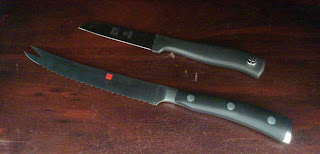Adding the proper
garnish is the easiest way to stress that drinking a cocktail isn’t just about
drinking something. It’s a special occasion, even when you casually make one
for yourself. You have to know (or look up) the recipe. You must have all the
required ingredients (and barware) on stock. You put effort and care in the
preparation. When you add a garnish as a finishing touch, it marks the cocktail
as a special, festive drink.
So while the addition
of a channel knife doesn’t strike as being the most crucial addition to the
collection of barware, it does a lot for the cocktails you serve.
Using a channel
knife, it’s easy to fabricate lemon twists. These twists are elegant and
cheerful; a lot of cocktail recipes specify the addition of a lemon twist. Lime
twists are also possible, but it’s advisable to use a fine channel knife for
the limes. For now, one channel knife that’s the proper size for lemon zest is
fine.
If you pull open the
twist over the cocktail before you add the garnish, it has the added benefit of
releasing oils over het surface.
Just be sure to wash the
peels of the lemons you are using for your garnish before you get to work with
your tool.
Since we also have a
knife at our disposal, almost all thinkable garnishes we can make with citrus
are now possible: citrus peel (an oval shaped piece of the zest), wheels,
half-wheels, wedges and twists. Sometimes the zest is cut up in a rectangular
shape.
There are other ways
to make a twist, by the way. But none are as easy as using this tool. The
twists from a channel knife are also very slender and can be made as long as
you want.
Aviation (reprise)
As promised, here’s
an Aviation complete with colouring from the violet liqueur and a lemon twist,
courtesy of the channel knife.





